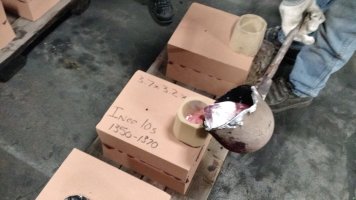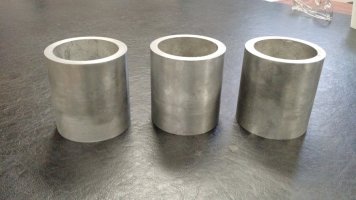Simon Beno
Member
- Mar 15, 2015
- 5
- 0
I really want to know?
I'm curious if you would try a self lubricating, lightweight, closer expansion rate to your aluminum blocks and cylinders, high thermal conductivity, high strength, aluminum graphite silicon carbide material. We have a service that can cast cylinder liners with solid graphite particles and solid silicon carbide nano particles evenly distributed through impregnation of the entire casting.
This means reduction in engine seizure. It also means no Nikasil, Alusil, Chrome, Moly-disulfide, or any other electroplating or plasma coating surface treatment is absolutely unnecessary.
We have been searching for the ideal dimensions for 4 stroke liner. Is there any common ground between liner dimensions and different engine manufacturers. We have mold sizes that are around 3.25" od 2.9" id by 3.5" tall. Would this fit in dirtbike OEMs across the board? What vehicles would this size liner fit into? The composite castings can be machine down to desired thickness. We recommend diamond honing stones due to the content of silicon carbide in the aluminum. We have been told it is easier to cut than Nikasil. We are a small but growing company 5 members strong. We are learning more and more everyday.
Questions for the racer:
How often do you replace your cylinder liners? Are they flaking?
Have you considered aluminum composites?
I want your opinion. Reply to this or email me and I can share more details. Thank you for your time let's talk.
Sincerely,
Simon
[email protected]



I'm curious if you would try a self lubricating, lightweight, closer expansion rate to your aluminum blocks and cylinders, high thermal conductivity, high strength, aluminum graphite silicon carbide material. We have a service that can cast cylinder liners with solid graphite particles and solid silicon carbide nano particles evenly distributed through impregnation of the entire casting.
This means reduction in engine seizure. It also means no Nikasil, Alusil, Chrome, Moly-disulfide, or any other electroplating or plasma coating surface treatment is absolutely unnecessary.
We have been searching for the ideal dimensions for 4 stroke liner. Is there any common ground between liner dimensions and different engine manufacturers. We have mold sizes that are around 3.25" od 2.9" id by 3.5" tall. Would this fit in dirtbike OEMs across the board? What vehicles would this size liner fit into? The composite castings can be machine down to desired thickness. We recommend diamond honing stones due to the content of silicon carbide in the aluminum. We have been told it is easier to cut than Nikasil. We are a small but growing company 5 members strong. We are learning more and more everyday.
Questions for the racer:
How often do you replace your cylinder liners? Are they flaking?
Have you considered aluminum composites?
I want your opinion. Reply to this or email me and I can share more details. Thank you for your time let's talk.
Sincerely,
Simon
[email protected]


